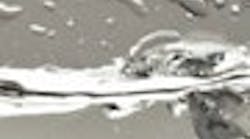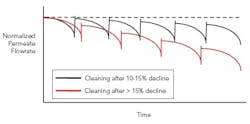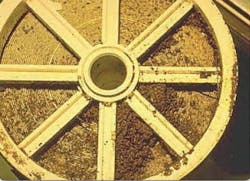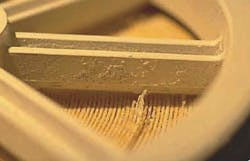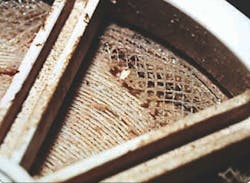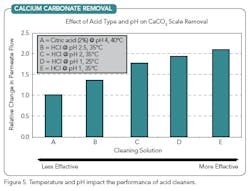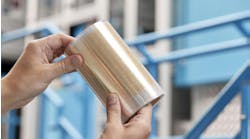Many processors striving to lower operating costs are missing an opportunity for savings in their reverse osmosis (RO) water treatment systems. Proactive steps to optimize both the cleaning frequency and cleaning method can extend the life of the installed membranes. Proper tracking of system performance combined with this optimized cleaning can reduce chemical, electrical and membrane-replacement costs. Additionally, a wise choice when it's time to replace membranes that operate in a fouling-prone environment can pay dividends.
MAINTAIN OPTIMAL OPERATION
Proper maintenance is the key to protect the investment in your current membranes. So, here, we'll look at some guidelines that can help you extend the productive life of the membranes and reduce overall operating costs of the RO plant.
The loss of permeate flow during operation is normal for a membrane system, so the first question is: "When to clean?" The frequency depends on the feed water source, operating parameters such as flux, and pretreatment. Commonly, systems are cleaned two-to-three times/year with well water, three-to-four times/year with city water, and four-to-six times/year with surface water. But it really depends on the specific situation. So, it's important to vigilantly look for signs of fouling. Any of the following observations should trigger a cleaning:
• Normalized permeate flow declines by 10–15%.
• Normalized feed pressure increases by 10–15%.
• Pressure drop rises by 10–15%.
• Normalized salt passage increases by 5–10%.
To make proper judgments, it's essential to normalize the permeate flow, feed pressure and salt passage to a standard reference point. Otherwise, fluctuations in feed temperature, salinity or pressure will either mask or accentuate the trends, leading to inaccurate conclusions about when to clean. Membrane suppliers can help provide software tools to normalize the data.
Foulants usually can be cleaned from the membrane surface with the right cleaning chemicals and good technique. Waiting too long to clean can permanently reduce RO performance (Figure 1).
ACHIEVE EFFECTIVE CLEANING
Before cleaning, it's very important to determine the type and location of the fouling:
• Colloidal and particle fouling (Figure 2) is specific to the first RO stage. (Its feed screen tends to catch these foulants.)
• Scaling (Figure 3) appears in the second stage. (Recovery of product water in this stage boosts the concentration of salts in the remaining water, possibly exceeding the solubility limit of certain salts.)
• Organic and microbiological fouling (Figure 4) can occur in either the first or second stage of the system.
Before starting to clean, find out the cleaning pH and temperature limits set by the membrane manufacturer and make sure the cleaning chemicals are compatible with the membranes.
Clean with alkaline cleaners first and then, if necessary, with acid. High-pH cleaners are more likely to break down fouling layers. Acid may react with organics, silica and biofouling, possibly leading to irreversible performance decline — that's why you should remove these foulants first with an alkaline cleaner.
Clean at the appropriate pH and temperature to remove the foulants:
• To remove biofouling, cleaning at pH 12 is much more effective than pH 11— about an order of magnitude better at restoring permeate flow. It's important to know the temperature range permissible for the membrane type at the high pH.
• To remove calcium carbonate scale, cleaning at lower pH and higher temperature restores permeate flow more fully (Figure 5). Some plants use citric acid (Cleaner A in the figure) to remove scale but it's usually not very effective compared to HCl at pH 1 (Cleaners D and E).
More extreme pH is more effective at removing foulants — but not all membrane manufacturers allow cleaning at a pH as high as 12 or as low as 1.
Different foulants require different cleaning protocols to achieve effective results. Consider the following guidelines (if the membrane can handle these conditions):
• Inorganic salts (such as CaCO3): 0.2 wt.% HCl, 25–40°C and pH 1–2.
• Metal oxide (such as iron): 1.0 wt.% sodium hydrosulfite (Na2S2O4), 25°C and pH 5.
• Inorganic colloids (silt), silica, biofilms and organic compounds: 0.1 wt.% NaOH, 35°C max and pH 12 or 0.1 wt.% NaOH and 0.025 wt.% Na-DSS [sodium salt of dodecylsulfate], 35°C max and pH 12.
USE THE PROPER PROTOCOL
The cleaning procedure is important. When mixing the cleaning solution, ensure all chemicals are dissolved and well mixed before circulating it through the membrane elements. When first introducing the cleaning solution into the RO system, use a low flow rate while the water in the system is displaced. Also, to avoid driving foulants into the membrane surface, apply only enough pressure to compensate for the pressure drop. Dump the concentrate stream at first for as long as necessary to prevent diluting the cleaning solution upon recycle.
Once cleaning chemicals have displaced water, recycle concentrate and permeate to the cleaning tank. Measure the pH and adjust as needed to maintain the desired value. Monitor the color of the cleaning solution — a color change indicates removal of foulants. Then dispose of the heavily contaminated cleaning solution and mix fresh solution. Continue this for as long as it appears new foulants are being removed. However, with an acid cleaning, recirculating for longer than 20–30 minutes increases the risk of any heavy metals falling out of suspension and becoming permanently embedded on the surface of the membrane, making it more difficult to clean.
Prepare fresh cleaning solution for the soaking step. The length of the soak varies. While alkaline cleanings may require an overnight soak, acid cleanings typically only need 30 minutes. To maintain the desired elevated temperature during an extended soak, use a low recirculation rate through the elements. As before, monitor the color of the cleaning solution and dispose or refresh the solution when you observe a color change.
After the soak, recirculate the cleaning solution at a high flow rate for 30–60 minutes to flush out foulants removed from the membrane surface. Finally, flush out the cleaning solution using RO permeate or deionized water. During the flush, the minimum temperature should be 20°C.
RETHINK MEMBRANE CHOICE
When it's finally time to replace RO membrane elements that handle fouling-prone water, check into technological developments introduced by membrane manufacturers to help mitigate fouling. For example, there's been a growing acceptance that elements with 34-mil spacers foul less quickly and are easier to clean than those with thinner spacers.
Membrane manufacturers continue to innovate in their quest to optimize spacer geometry and thus flush the membrane surface more effectively. Work also is advancing to improve the fouling-resistant properties of the spacer material and membrane surface.
All these development efforts aim to extend the time between cleanings, improve the effectiveness of cleaning, and lengthen the overall lifetime of the membranes. Plants benefit from lower operating costs via: 1) decreased consumption of cleaning chemicals due to less frequent cleanings, 2) less electricity use due to slower increases in feed pressure, and 3) reduced membrane replacement costs due to longer life.
CUT COSTS
As this article has stressed, timely and proper membrane maintenance is necessary to ultimately achieve the lowest operating costs.
Monitor the condition of the plant, normalize and assess the data, and use the results to decide when to clean so membrane performance isn't irreversibly reduced.
Before starting to clean, determine the type of fouling and its location so you can use the proper cleaning chemical. Cleaning at more extreme pH is much more effective — but first always check the membrane manufacturer's literature for pH (and temperature) limits for cleaning.
Waiting too long to clean will shorten membrane life and cost far more than appropriate cleaning to keep membranes healthy.
GREGG POPPE is a global application development specialist at Dow Water & Process Solutions, Edina, Minn. E-mail him at [email protected].
